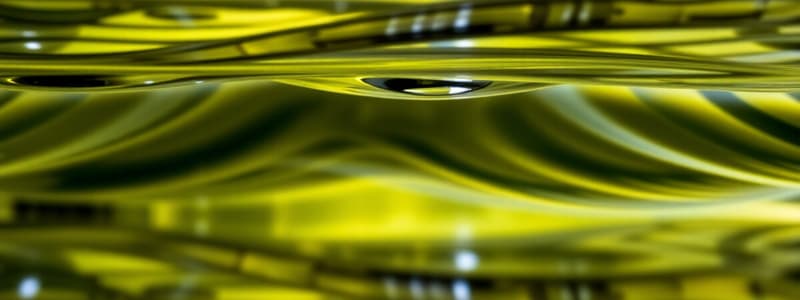Podcast
Questions and Answers
In which medium does light travel the fastest?
In which medium does light travel the fastest?
- Water
- Glass
- Vacuum (correct)
- Air
What happens to light when it travels from air to glass?
What happens to light when it travels from air to glass?
- It reverses direction.
- It slows down and bends towards the normal line. (correct)
- It remains unchanged.
- It speeds up and bends away from the normal line.
What characterizes optically denser materials compared to optically rarer materials?
What characterizes optically denser materials compared to optically rarer materials?
- Particles are further apart.
- Light travels at the same speed.
- They reflect light more effectively.
- Particles are closer together. (correct)
When light moves from a denser medium to a rarer medium, what occurs?
When light moves from a denser medium to a rarer medium, what occurs?
Which of the following statements is true concerning light traveling in different media?
Which of the following statements is true concerning light traveling in different media?
Which medium is considered to be optically rarer?
Which medium is considered to be optically rarer?
What occurs to the direction of light as it transitions from glass to air?
What occurs to the direction of light as it transitions from glass to air?
What is the key characteristic of regular reflection?
What is the key characteristic of regular reflection?
Which of the following materials would most likely cause diffused reflection?
Which of the following materials would most likely cause diffused reflection?
What happens to light as it travels from a rarer medium to a denser medium?
What happens to light as it travels from a rarer medium to a denser medium?
What is the definition of refraction?
What is the definition of refraction?
Which angle is formed when light hits a surface before being reflected?
Which angle is formed when light hits a surface before being reflected?
What type of surfaces produce regular reflection?
What type of surfaces produce regular reflection?
Light passing through a prism bends due to which phenomenon?
Light passing through a prism bends due to which phenomenon?
What describes a rarer medium in comparison to a denser medium?
What describes a rarer medium in comparison to a denser medium?
Flashcards
Regular Reflection
Regular Reflection
Light bouncing off a smooth surface in a single direction.
Diffused Reflection
Diffused Reflection
Light bouncing off a rough surface in multiple directions.
Refraction
Refraction
The bending of light as it passes from one medium to another.
Denser Medium
Denser Medium
A medium through which light travels slower.
Signup and view all the flashcards
Rarer Medium
Rarer Medium
A medium through which light travels faster.
Signup and view all the flashcards
Angle of incidence
Angle of incidence
The angle between the incident ray and the normal line.
Signup and view all the flashcards
Angle of refraction
Angle of refraction
The angle between the refracted ray and the normal line.
Signup and view all the flashcards
Light travels slower in a denser medium.
Light travels slower in a denser medium.
Light slows down when it passes from a rarer medium to a denser medium.
Signup and view all the flashcards
Light speed in denser media
Light speed in denser media
Light travels slower in denser materials.
Signup and view all the flashcards
Denser vs. Rarer materials (optically)
Denser vs. Rarer materials (optically)
Dense materials have particles closer together, while rarer materials have particles further apart. This affects how light travels.
Signup and view all the flashcards
Refraction - light bending
Refraction - light bending
Light bending as it passes from one medium (material) to another of different density.
Signup and view all the flashcards
Light from Rare to Dense
Light from Rare to Dense
When light goes from a less dense to a denser medium, it bends towards the normal line.
Signup and view all the flashcards
Light from Dense to Rare
Light from Dense to Rare
When light goes from a denser to a less dense medium, it bends away from the normal line.
Signup and view all the flashcards
Normal Line
Normal Line
An imaginary line perpendicular to the surface where light passes from one material to another.
Signup and view all the flashcards
Optical Density
Optical Density
A measure of how much a material slows down light.
Signup and view all the flashcardsStudy Notes
Waves and Their Applications
- Unit 1 - Module L
- Standard MS-PS4-2: Develop and use a model to describe that waves are reflected, absorbed, or transmitted through various materials.
Day 1 - Regular & Diffused Reflection/Refraction
- Objectives:
- Define regular and diffused reflection
- Define refraction
- Label reflected and refracted ray diagram
- Explain how refraction takes place
- Compare regular and diffused reflection
- Vocabulary:
- Refraction
- Angle of incident
- Angle of refraction
- Diffused
- Regular
Regular Reflection
- Light bounces off a smooth surface.
- Light reflects in a uniform/single direction.
- Examples: mirrors, polished metals, calm water, CDs, DVDs
Diffused Reflection
- Light bounces off a rough surface.
- Light reflects in different/multiple directions.
- Examples: walls, wood, irregular objects (bags, books, paper, people)
Starter Activity
- What is the difference between the two pictures shown? (Illustrative pictures showing regular vs. diffuse reflection)
Refraction
- Light travels through a medium.
- Light slows down and bends.
- The bending of light as it passes from one medium to another is called refraction.
- The prism bends light.
Labeling Parts of Refraction Diagram
- Incident ray
- Normal
- Angle of incidence
- Boundary
- Substance 1
- Substance 2
- Angle of refraction
- Refracted ray
Label C and D
- Component C on diagram
- Component D on diagram
Day 2 - Light Refraction
- Objectives:
- Draw and label refraction diagram
- Define denser and rarer medium
- Explain how light travels from a rarer medium to a denser medium (and vice versa)
- Compare and contrast denser and rarer medium
- Vocabulary:
- Rarer media
- Denser media
Starter Activity (Day 2)
- Label the ray diagram showing refraction and reflection of light.
Previous Knowledge
- Light travels slower in denser/thicker materials (Solid > Liquid > Gas > Vacuum)
Which is denser/thicker?
- Air or glass? Answer: Glass
- Light travels slower in glass than in air.
- Light bends as it goes slower.
- Glass is optically denser (particles are closer)
- Air is optically rarer (particles are further away)
Checking Understanding
- Describe any refraction of light in your classroom. Include its speed, bend, media (denser or rarer), etc.
Summary of Light Travel from Optically Rare to Dense
- When light travels from optically rare (e.g., air) to optically denser (e.g., glass):
- Light travels slower
- Light bends towards the normal
Summary of Light Travel from Optically Dense to Rare
- When light travels from optically dense (e.g, glass) to optically rarer (e.g., air):
- Light travels faster.
- Light bends away from the normal
Think Pair Share - Check Your Understanding
- Choose the correct sketch showing the situation, the interface between media, the normal line, the incident ray, and the reflected rays.
Group Work - Practice Drawing (Peer Evaluation)
- Draw the reflected light in the diagrams below.
- Exchange papers with another group
- Evaluate each other's work using the teacher's answer key
- Post completed work.
Compare Denser And Rarer Media
- Denser media: Light travels slower, closer particles
- Rarer media: Light travels faster, further away particles
Activity - Quizizz
- Participate in a quiz related to absorption, reflection, and refraction using the provided link.
Studying That Suits You
Use AI to generate personalized quizzes and flashcards to suit your learning preferences.




